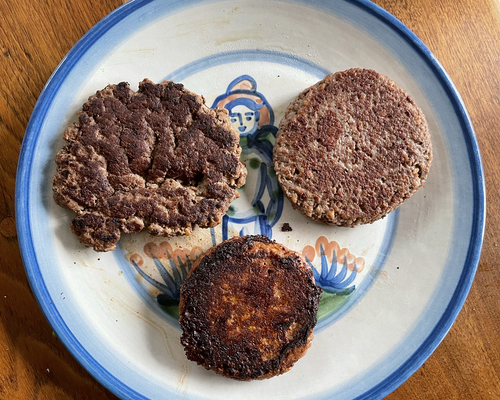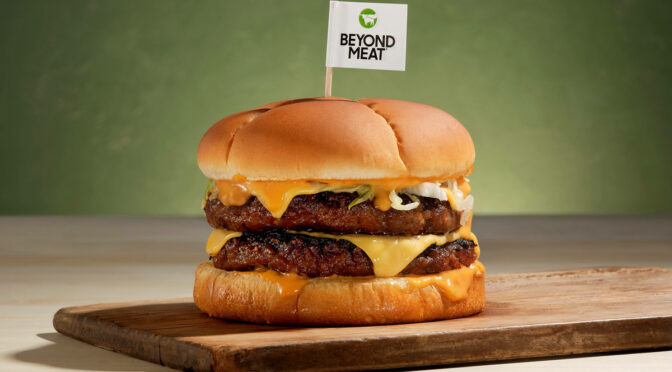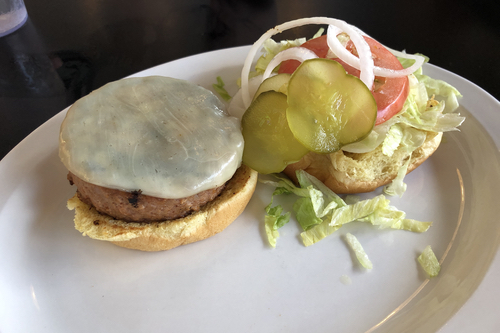By Robin Garr
LouisvilleHotBytes.com
I’ve said it before, and I’ll say it again: I actually like Beyond Meat, Impossible, and the rest of the growing cadre of plant-based, meat-like alternative proteins. I think they’re better for the environment than meat, better for me, certainly better for the animals sacrificed in the meat industry. And I think they taste good.
This shouldn’t be a controversial statement, and yet, like so much else in modern life, it’s possible that someone out there reading this is feeling a burning rage at the very idea of praising meat made from vegetables. That’s right. Even meat vs. not-meat can be a political wedge issue in these troubled times.
“Plant-based meat may be getting caught in the culture wars, and U.S. brands that emphasize climate and environmental concerns may be putting off conservative consumers who are reluctant to try such products,” Jennifer Yule, lecturer in marketing at the University of Edinburgh, Scotland, wrote in Green Queen, an online food and climate journal. “The issue of climate change and environmental concern is politically polarizing.”
Another report indicated that more than half (53%) of U.S. consumers who have not bought or tried plant-based meat may be reluctant to buy a product they view as “woke.”
Meat vs the environment?
Still, meat’s impact is not a trivial matter. Livestock production is the agriculture sector’s largest emitter of the potent greenhouse gas methane, due to emissions from ruminants such as cattle, sheep, and goats, reported Rob Jordan with the Stanford Woods Institute for the Environment.
“It’s also the main direct cause of tropical deforestation, due to pasture expansion and feed crop production,” Jordan’s report went on. “Numerous studies have demonstrated that dietary changes hold great potential to reduce humanity’s ecological footprint, especially a reduction in red meat consumption. At the same time, Western-style meat-heavy diets are becoming more popular around the world.”
Now, before steam starts coming out of your collar, there’s plenty of evidence that red meat isn’t necessarily bad for us. “There are many healthy vitamins, minerals and other nutrients in red meat, and it can be a good source of protein, B vitamins, iron and zinc,” reports The Cleveland Clinic.
But then Cleveland Clinic attaches a zinger: “But it also comes with some health risks, like raising your risk of certain types of cancer, increasing your risk of cardiovascular disease and contributing to obesity.”
A matter of balance
It’s all a matter of balance, according to the clinic’s registered dietitian Julia Zumpano: “There is evidence that shows that too much red meat is not good for your health. But the quality, quantity and frequency of the red meat you eat all play a big role on the health risks.”
Those sound like reasonable arguments to steer clear, or more realistically, to consider red meat as an occasional special treat. On the other hand, the current alternatives draw criticism too, for a variety of reasons that go beyond the political.
Check the nutrition and ingredients level, for instance, and you’ll find that many plant-based meats are high in sodium and loaded with chemistry-set preservatives and additives that most of us find hard to spell and impossible to pronounce. In short, they’re highly processed foods, a category that many people try to avoid in their quest for natural, whole food products.
There’s also the matter of cost. Barring great sales or discounts, Impossible and Beyond burgers aren’t cheap. A pound of Beyond Beef was recently marked at $8.99 per pound at Kroger. Shop carefully and you can generally find packaged ground beef for $4 or less at local markets. On the other hand, a a 10-pound box of ground sirloin from Foxhollow Farm was selling for $140 the other day. That’s $14 a pound, which makes Impossible look like such a deal.
Allergens may come into play, particularly with soy-based Impossible, which also inspires fears in the GMO-wary with its meat-mimicking heme, a genetically modified soybean protein called leghemoglobin that’s a laboratory-built, meat-free cousin to the hemoglobin that gives beef its characteristic taste.
All these concerns may hint at why plant-based burgers appear to have plateaued in the past few years after a spell of startling market growth. According to Food Business News, plant-based meat sales have declined since 2021, showing a 21% decrease in volume sales for the yearlong period ending July 2, 2023. Meanwhile, investments in all alternative proteins including plant-based meat, seafood, eggs and dairy fell 41% during 2022.
But how do they taste?
Finally, there’s the question of taste. I like Impossible and Beyond. Not everyone agrees. “The texture was sickening,” my friend David said. “We tried ihe beef subs and were underwhelmed,” added my friend Alyce. Their thoughts, I think, are widely held.
So what’s a food writer to do? A taste test! We picked up Impossible and Beyond burger patties at Kroger, and stopped by old favorite Shady Lane Cafe (ShadyLaneKY.com) for an estimable beef burger fashioned on a flat-top grill.

All three tasted like burgers, as you’d expect. The Beyond burger took on a delicious charred crust and darker brown color in an iron skillet, a benefit that the Impossible lacked thanks to the non-stick skillet requirement in its cooking instructions, which left it a paler shade of beige.
Both alternative burgers passed the beefy flavor test, and either would make a fine substitute if you want to avoid meat. Served on a bun with lettuce, tomato, mayo, and ketchup or mustard, it would be difficult for many people to realize that they’re not eating cow meat. If you’re consciously avoiding meat, either one would absolutely fill a burger-size space in your crave.
But this has to be said: Side by side without the distraction of other ingredients, neither alternative burger quite matched the intensely meaty meat taste of the beef burger. If that’s what you’re looking for, then it’s entirely reasonable for you to ask “where’s the beef?”





